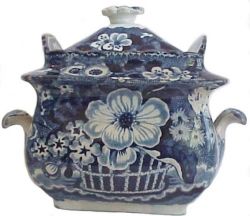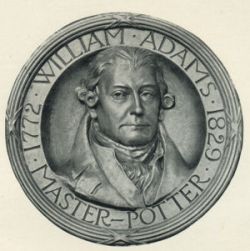William Adams & Sons
William Adams and The Adams Family
William Adams I (1746-1805) was born within weeks of his father’s death and inherited a potworks at St John’s Square, Burslem. His mother died before he was one year old and he was raised by his grandfather who managed the factory until William came of age. By 1779 he was also potting at the Greengates Works in Tunstall: by 1786 Greengates had been enlarged and a third factory acquired at Newfield, Tunstall. William Adams I was an accomplished potter whose best known products included stonewares, jasper and basalt of the highest quality. Pieces are recorded impressed ‘ADAMS’ and ‘ADAMS & CO’. At his death in 1805, his son Benjamin was still a minor and it is said that the business was carried on by his elder sister Mary until Benjamin took over the works on attaining his majority in 1809. Amongst his recorded output are stonewares and blue printed earthenwares impressed ‘B. ADAMS’. The marked blue printed wares are of a light blue tone and none feature American subjects. The firm encountered financial difficulties and closed in 1820, the Greengates factory being acquired by John Meir. William Adams II (1748-1831) of the Brick House Works Cobridge was a minor when his father died: during his minority the pottery was let to Josiah Wedgwood during which time it was known as the Bell Works. William Adams II took over the pottery when he attained majority in 1769, Wedgwood then moving to the newly built Etruria. During his potting career, this William owned or occupied several factories both alone and in partnership with others, but no marked ware of his manufacture has ever been identified. William Adams III of Fenton Hall and Bagnall (1772 -1829.), was the son of Richard Adams of Cobridge (1739-1811) and was the founder of the firm whose products are featured on this site. Having been in an earlier partnership for some years, William III set up on his own account at Cliff Bank, Stoke in 1804, where he manufactured general earthenware including blue printed pottery. William III had four sons: from 1819 onwards he successively took his sons into partnership and the business was extended to a very large size, by the mid-19th century occupying no less than six factories, both at Stoke and Tunstall. It is written that William, son of William Adams III had travelled to America and established a business in New York in the name of Adams Brothers. This is difficult to confirm, but John Ridgway noted meeting Mr Adams of Stoke when he was in New York in November, 1822[ii]. The firm had an extensive American trade and the letters of Matthew Smith, the Baltimore importer, to his Liverpool agents contain several references to his dealings with them; that of 11th November 1826 includes the most detailed: . ‘..You may try Heath or Adams. Try and get a new, tasty shape for the blue print’d Jugs or for a part of them – a shape there was a sample of from Adams on a foot, I think, would please – only it must be entirely covered on the outside – on the samples there is a bare streak by the foot. …I have nothing to say against the Blue Print’d Table Ware from Adams, it will do again. The fancy cans were a poor article & too dear. The painted ware – Bowls, Sugars, Creams appear to be the small sizes – 12/30 doz. Of Ginder’s fancy Col’d are worth 5 Cts pr doz. more than the painted Bowls of Adams…’[iii] The very substantial quantity of marked pieces to be found in America is indicative both of the size of the firm and the importance of its export trade to the United States. Documentary evidence dating to 1840-41 gives the number of employees at the three factories comprising the Lower Works Stoke as 578 and states We do chiefly with the North and South American market, and but little for home [iv]. Despite the size of the business, only two printed patterns in the dark blue tone with specifically American subjects have been recorded; one is ‘The Seal of the United States’, the other ‘Mitchell & Freeman’s China and Glass Warehouse, Chatham St, Boston.’ The subject matter of the latter helpfully dates it to around 1828-31, placing wares with this pattern towards the latter end of the fashionable period for the very dark blue. [i] The interrelationships of the family are complex and have been the subject of numerous publications A fuller account of the history of the family and the firms can be found in Furniss, David A., J. Richard Wagner, and Judith Wagner. (1999). Adams ceramics: Staffordshire potters and pots, 1779-1998. Atglen, PA: Schiffer Pub.And in Adams, P.W.L. (1914). A History of the Adams Family of North Staffordshire & of Their Connection with the Development of the Potteries: With Numerous Pedigree Charts & Notes on Allied Families. London: St Catherine Press. [ii] Diary entry for Friday, November 22, 1822. The diary is in the collection of The Potteries Museum & Art Gallery, Stoke-on-Trent. [iii] Pomfret, Roger. (2010). “A Staffordshire Warehouse in Baltimore: the Letter Books of Matthew Smith 1806-32” Northern Ceramic Society Journal Vol.26. p. 97. [iv] Report of Parliamentary Commission on Employment of Children and Young Persons, published in 1843. |
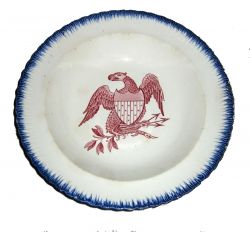 Blue edged plate with print of American Eagle Wiliam Adams & Sons Blue edged plate with print of American Eagle Wiliam Adams & SonsWinterthur Museum
William Adams & Sons 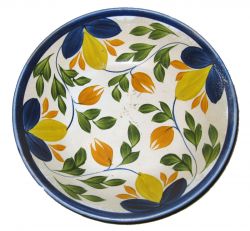 Pearlware with painted decorationWilliam Adams & Sons Pearlware with painted decorationWilliam Adams & SonsWinterthur Museum
|

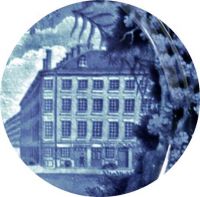 Several branches of the Adams family
operated factories in the Staffordshire Potteries in the latter half of the 18th
and early part of the 19th centuries, including three men named William
Adams, who have come to be known as
William Adams I, II and III.
Several branches of the Adams family
operated factories in the Staffordshire Potteries in the latter half of the 18th
and early part of the 19th centuries, including three men named William
Adams, who have come to be known as
William Adams I, II and III.